Are you fascinated by the incredible journeys of hummingbirds? Do you wonder how these tiny creatures manage to travel thousands of miles each year? At SIXT.VN, we understand your curiosity and are here to guide you through the fascinating world of hummingbird migration, offering insights and perhaps inspiring your own travel adventures in Vietnam. Discover the secrets of their migration and plan your perfect trip with our expert travel services, including airport transfers, hotel bookings, and exciting tours.
1. Why Do Hummingbirds Migrate South for the Winter?
Hummingbirds migrate south for the winter primarily in search of food sources, such as flowers and insects. Like other migrating birds, hummingbirds move to areas where they can find abundant food and suitable climates during the colder months.
Hummingbirds, despite their ability to thrive in various North American regions during summer, are fundamentally tropical birds. As the seasons change and daylight hours decrease, these tiny creatures embark on long journeys to warmer climates like Mexico and Central America. This migration is driven by the need to find consistent food sources – nectar from flowers and small insects – which become scarce in northern regions during winter. According to research from the U.S. Fish and Wildlife Service in 2022, decreasing daylight hours are the primary trigger for migration, even before temperatures drop significantly.
2. Which Hummingbird Species Migrate and Where Do They Go?
Several hummingbird species migrate, including the Ruby-throated, Rufous, Black-chinned, and Allen’s Hummingbirds, each with specific destinations. The majority of North American hummingbirds fly to Mexico or Central America for the winter, seeking warmer climates and abundant food sources.
- Ruby-throated Hummingbird: These tiny birds, weighing just a penny, undertake impressive journeys to southern Mexico and Central America. Some remain along the southern United States’ Atlantic and Gulf Coasts, typically migrants from Canada who have already traveled thousands of miles. According to the IUCN, the Ruby-throated Hummingbird is a species of Least Concern, with populations on the rise due to backyard feeders and adaptability to open and forest-edge habitats.
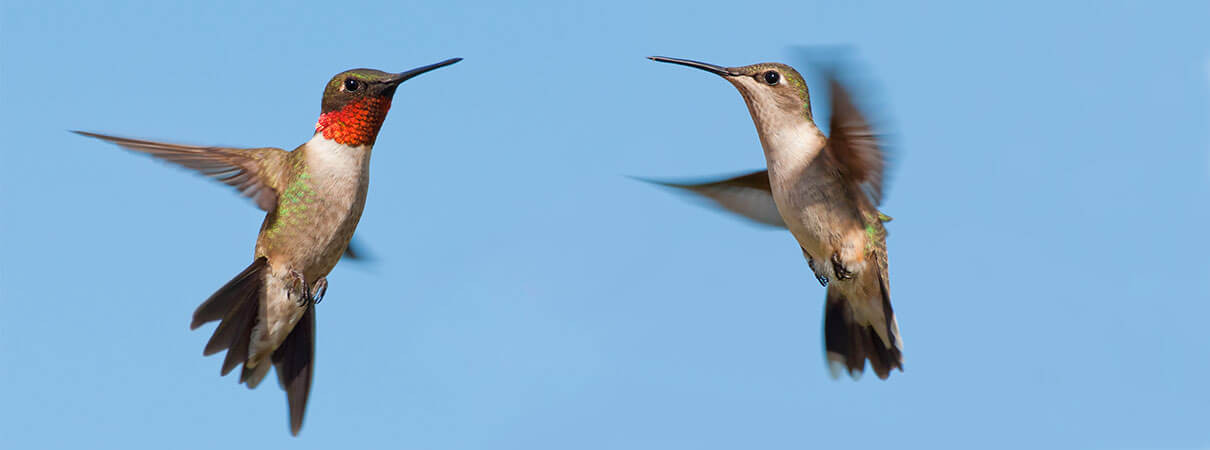 Ruby-throated Hummingbirds in Flight
Ruby-throated Hummingbirds in Flight
Alt text: Ruby-throated Hummingbirds migrating during daylight, showcasing their vibrant colors.
- Rufous Hummingbird: This species makes one of the longest migratory trips for its size, traveling approximately 3,900 miles. Their route forms a clockwise loop, starting from Mexican wintering grounds in early spring to Washington State and Canada by May, then south through the Rocky Mountains. Habitat loss has led to a decline in Rufous Hummingbird populations, classifying it as an IUCN Near Threatened species.
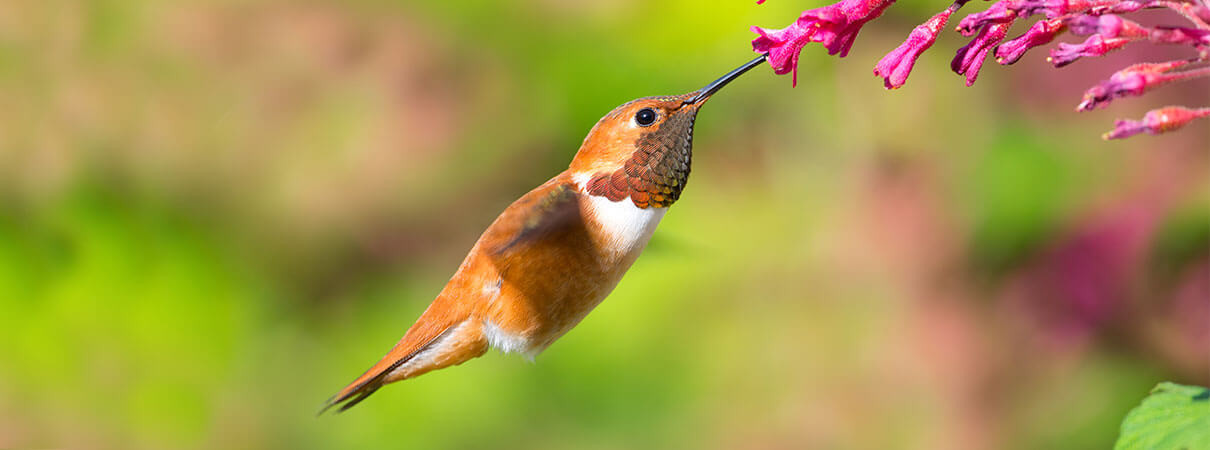 Rufous Hummingbird Perched on a Branch
Rufous Hummingbird Perched on a Branch
Alt text: A Rufous Hummingbird perched gracefully on a branch, its striking orange plumage highlighted.
- Black-chinned Hummingbird: These adaptable birds occupy a large portion of the western United States during summer. After breeding, they move to higher elevations to feed on mountain flowers before heading to western Mexico or overwintering along the Gulf Coast. The Black-chinned Hummingbird’s populations are increasing, thanks to backyard feeders and its tolerance for varied habitats, earning it an IUCN status of Least Concern.
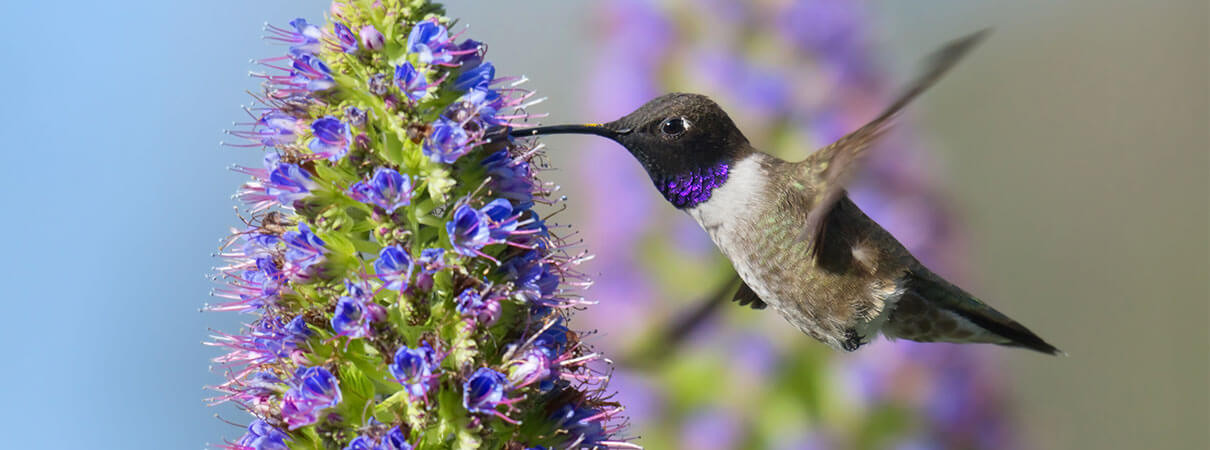 Black-chinned Hummingbird Feeding
Black-chinned Hummingbird Feeding
Alt text: Black-chinned Hummingbird gracefully sipping nectar from a vibrant flower.
- Allen’s Hummingbird: Allen’s Hummingbirds migrate early, departing their wintering grounds in early December to arrive in California and Oregon by January. One subspecies migrates to central Mexico, while the other stays in southern California. Despite being fairly common, their numbers have decreased by 83 percent in recent decades, according to Partners in Flight.
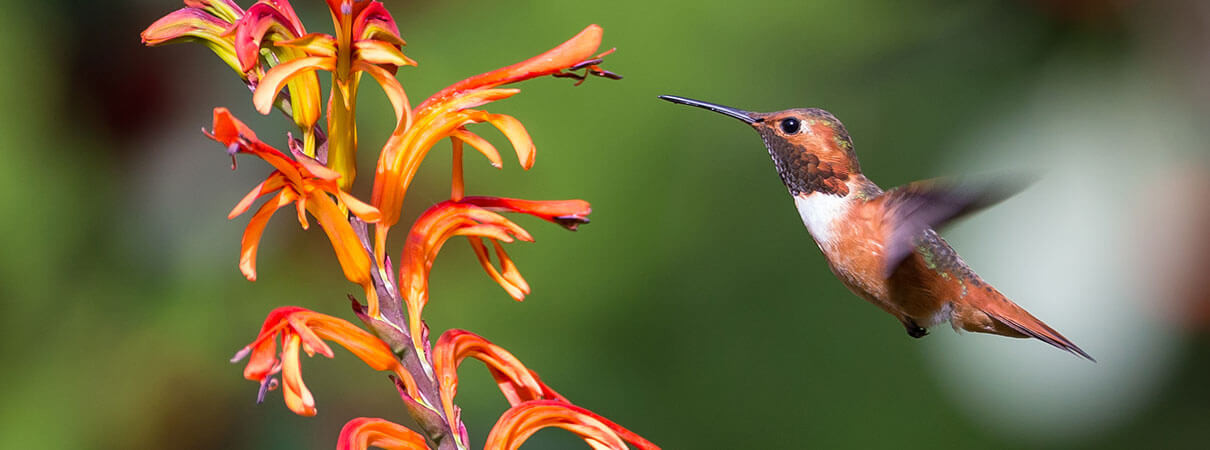 Allen's Hummingbird Hovering
Allen's Hummingbird Hovering
Alt text: A hovering Allen’s Hummingbird displays its agility and vibrant coloration.
Understanding these migration patterns can enhance your appreciation for these tiny travelers. And just like these birds, you can plan your perfect migration—or vacation—with SIXT.VN. We offer seamless airport transfers, comfortable hotel bookings, and unforgettable tours to make your journey as smooth as possible.
3. How Far Do Hummingbirds Travel During Migration?
Hummingbirds travel varying distances during migration, ranging from 500 miles to 3,900 miles, depending on the species and their destination. The Rufous Hummingbird, for instance, undertakes one of the longest migrations for its size, traveling approximately 3,900 miles.
The Ruby-throated Hummingbird can cross the Gulf of Mexico in a single flight, covering 500 miles in about 18-20 hours. This incredible feat highlights their endurance and determination. Data from the American Bird Conservancy indicates that these journeys are influenced by favorable wind conditions and available food sources along the way.
4. When Do Hummingbirds Start Their Migration South?
Hummingbirds typically start their migration south in late summer and fall, usually between mid-July and late September, triggered by decreasing daylight hours. While some adults may begin as early as mid-July, most Ruby-throated Hummingbirds wait until late August or early September to set off for their wintering grounds.
The timing of migration is influenced by a combination of factors, including changes in daylight length and the availability of food. According to a 2023 report by the Cornell Lab of Ornithology, hummingbirds also use environmental cues such as temperature changes and the blooming cycles of specific flowers to time their departure.
5. How Do Hummingbirds Prepare for Their Long Journey?
Hummingbirds prepare for their long journey by increasing their body weight significantly, storing fat reserves to fuel their flight. Before migrating, hummingbirds enter a state of hyperphagia, consuming large amounts of nectar and insects to build up fat reserves.
These reserves are crucial for providing the energy needed to fly hundreds or even thousands of miles. Research from the University of California, Berkeley, indicates that some hummingbirds can nearly double their body weight before migration. This additional weight, primarily in the form of fat, acts as fuel for their long flights, ensuring they have the energy to reach their destination.
6. How Fast Do Hummingbirds Fly During Migration?
Hummingbirds can fly at speeds of up to 30 miles per hour during migration, often aided by favorable winds. While their typical flight speed ranges from 20 to 30 miles per hour, hummingbirds can reach higher speeds when diving or flying with a tailwind.
According to the National Audubon Society, hummingbirds can also adjust their flight speed to conserve energy, slowing down when headwinds are present and speeding up when flying with the wind. This adaptability is essential for completing their long migrations successfully.
7. Do Hummingbirds Migrate Alone or in Flocks?
Hummingbirds typically migrate alone, although they may sometimes travel in mixed flocks over water. Unlike some bird species that migrate in large groups, hummingbirds are generally solitary migrants.
However, they may occasionally join mixed flocks of other bird species for protection or to take advantage of favorable flying conditions. Observations from birdwatchers along the Gulf Coast have noted that hummingbirds sometimes travel alongside warblers and other small birds during their trans-Gulf migration.
8. How Do Hummingbirds Navigate During Migration?
Hummingbirds navigate during migration using a combination of innate instincts, landmarks, and possibly the Earth’s magnetic field. While the exact mechanisms are still being studied, scientists believe that hummingbirds rely on several cues to find their way.
These include:
- Innate Instincts: Hummingbirds have an inherent sense of direction that guides them along their migratory routes.
- Landmarks: They use visual cues such as mountains, rivers, and coastlines to stay on course.
- Magnetic Field: Some research suggests that hummingbirds may also be able to detect and use the Earth’s magnetic field for navigation.
A study published in the journal Behavioral Ecology found that young hummingbirds are able to navigate to their wintering grounds even without the guidance of experienced adults, suggesting a strong genetic component to their navigational abilities.
9. What Challenges Do Hummingbirds Face During Migration?
Hummingbirds face numerous challenges during migration, including habitat loss, lack of food sources, weather conditions, and predators. These tiny birds encounter a variety of obstacles on their long journeys, making migration a perilous undertaking.
Key challenges include:
- Habitat Loss: The destruction of natural habitats along their migratory routes reduces the availability of food and shelter.
- Lack of Food Sources: Depletion of nectar-rich flowers and insect populations can leave hummingbirds without the energy they need to continue their journey.
- Weather Conditions: Strong winds, storms, and cold temperatures can exhaust or disorient hummingbirds, making it difficult for them to find food and shelter.
- Predators: Hummingbirds are vulnerable to predators such as birds of prey, snakes, and even large insects.
The American Bird Conservancy is actively working to address these challenges by protecting and restoring critical hummingbird habitats, promoting bird-friendly landscaping practices, and educating the public about the importance of hummingbird conservation.
10. How Can We Help Hummingbirds During Their Migration?
We can help hummingbirds during their migration by providing food sources, creating suitable habitats, and supporting conservation efforts. There are several ways to support these tiny travelers and ensure their survival.
Simple steps include:
- Providing Food Sources: Planting native, nectar-rich flowers in your garden can provide a reliable food source for migrating hummingbirds. You can also put up hummingbird feeders filled with a sugar-water solution (one part sugar to four parts water).
- Creating Suitable Habitats: Providing shelter and nesting sites by planting trees and shrubs can help hummingbirds rest and recover during their migration.
- Supporting Conservation Efforts: Donating to organizations that protect and restore hummingbird habitats can make a significant difference in their survival.
By taking these actions, we can help hummingbirds successfully complete their migrations and thrive in their summer and winter homes. According to research from the National Wildlife Federation, even small efforts can have a big impact on local hummingbird populations.
11. Are There Hummingbird Species That Don’t Migrate?
Yes, some hummingbird species, such as Anna’s Hummingbird, do not migrate and remain in their habitat year-round. In contrast to most North American hummingbirds, Anna’s Hummingbirds do not migrate, although they may move short distances to search for additional food sources.
Anna’s Hummingbirds now occupy an area of habitat stretching from northern Mexico to Southern Canada, but this wasn’t always the case: During the first part of the 20th century, the bird’s breeding range was much smaller, restricted to Baja, Mexico, and southern California. This changed with the introduction of exotic flowering trees along the West Coast, which provided additional nectar supplies and nesting opportunities. Anna’s Hummingbird populations are also growing thanks to the popularity of backyard hummingbird feeders. This bird is an IUCN species of Least Concern.
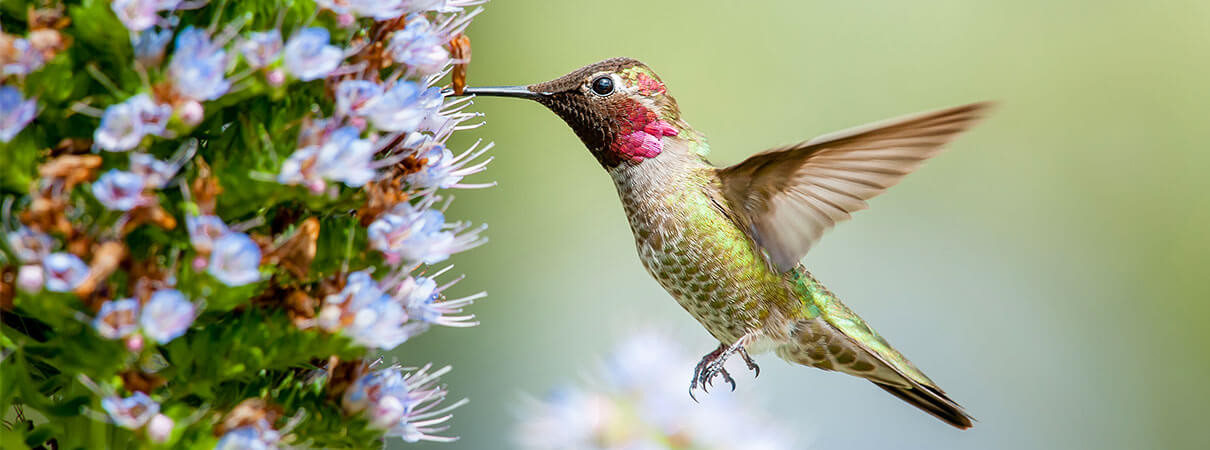 Anna's Hummingbird on a Branch
Anna's Hummingbird on a Branch
Alt text: Anna’s Hummingbird perched on a branch, displaying its iridescent plumage.
12. How Do Climate Change and Habitat Loss Affect Hummingbird Migration?
Climate change and habitat loss significantly impact hummingbird migration patterns and survival rates by disrupting food sources and breeding grounds. These environmental changes pose serious threats to hummingbird populations.
Here’s how:
- Climate Change: Altered weather patterns, such as prolonged droughts and extreme temperatures, can affect the blooming cycles of nectar-rich flowers, reducing the availability of food for migrating hummingbirds.
- Habitat Loss: Deforestation, urbanization, and agricultural expansion destroy critical hummingbird habitats, leaving them with fewer places to rest, feed, and breed.
A 2021 study by the Intergovernmental Panel on Climate Change (IPCC) warned that these impacts are likely to intensify in the coming years, posing an even greater threat to migratory bird species like hummingbirds.
13. What Role Do Backyard Feeders Play in Hummingbird Migration?
Backyard feeders play a crucial role in supporting hummingbird migration by providing a reliable source of energy, especially when natural food sources are scarce. The popularity of backyard hummingbird feeders has contributed to the rise in populations of several hummingbird species.
These feeders offer a consistent supply of sugar-water, which helps hummingbirds build up their fat reserves before migration and sustain them during their long journeys. However, it’s essential to maintain feeders properly to prevent the spread of diseases and ensure that the sugar-water solution is fresh and clean.
14. What Are Some Interesting Facts About Hummingbird Migration?
Hummingbird migration is full of fascinating facts, including their ability to cross the Gulf of Mexico in a single flight and their incredibly long journeys relative to their size. These tiny birds are full of surprises.
Here are some intriguing facts:
- Trans-Gulf Migration: Ruby-throated Hummingbirds can fly non-stop across the Gulf of Mexico, covering 500 miles in about 18-20 hours.
- Long-Distance Travel: The Rufous Hummingbird travels approximately 3,900 miles during its migration, one of the longest journeys relative to its size in the bird world.
- High-Altitude Flight: Hummingbirds have been observed flying at altitudes of up to 10,000 feet during migration, allowing them to take advantage of favorable wind patterns.
- Flexible Timing: Hummingbirds can adjust the timing of their migration based on weather conditions and food availability, demonstrating their adaptability and resilience.
These facts highlight the remarkable abilities of hummingbirds and underscore the importance of protecting them and their habitats.
15. How Can I Plan a Birdwatching Trip to Observe Hummingbird Migration?
Planning a birdwatching trip to observe hummingbird migration involves researching peak migration times, identifying key locations, and preparing for outdoor conditions. Observing these tiny birds in their natural habitat can be an unforgettable experience.
Here’s how to plan your trip:
- Research Peak Migration Times: Find out when hummingbirds are most likely to be migrating through your area. This information can be found on birding websites, in field guides, and from local birdwatching groups.
- Identify Key Locations: Look for parks, nature reserves, and other areas with abundant nectar-rich flowers and suitable habitats for hummingbirds.
- Prepare for Outdoor Conditions: Wear comfortable clothing and shoes, bring binoculars, a field guide, and plenty of water. Be prepared for changing weather conditions and potential insect bites.
- Respect Wildlife: Observe hummingbirds from a distance, avoid disturbing their habitats, and follow all park rules and regulations.
With careful planning and preparation, you can enjoy a rewarding birdwatching experience and witness the incredible phenomenon of hummingbird migration firsthand.
16. What are the Conservation Statuses of Migratory Hummingbird Species?
The conservation statuses of migratory hummingbird species vary, with some listed as Least Concern and others as Near Threatened due to habitat loss and other threats. These statuses reflect the challenges these birds face.
Here are the conservation statuses of some common migratory hummingbird species, according to the IUCN Red List:
| Species | Conservation Status |
|---|---|
| Ruby-throated Hummingbird | Least Concern |
| Rufous Hummingbird | Near Threatened |
| Black-chinned Hummingbird | Least Concern |
| Allen’s Hummingbird | Declining Numbers |
These classifications highlight the importance of ongoing conservation efforts to protect migratory hummingbird species and ensure their long-term survival.
17. Where Can I Find More Information About Hummingbird Migration?
You can find more information about hummingbird migration from reputable sources such as the American Bird Conservancy, the Cornell Lab of Ornithology, and the National Audubon Society. These organizations offer a wealth of resources.
These resources include:
- Websites: These organizations’ websites offer detailed information about hummingbird migration patterns, conservation efforts, and how to help hummingbirds in your area.
- Field Guides: Field guides provide information about hummingbird identification, behavior, and habitat preferences.
- Scientific Publications: Scientific journals and research papers offer in-depth analyses of hummingbird migration and related topics.
- Local Birdwatching Groups: Local birdwatching groups can provide information about hummingbird sightings in your area and offer opportunities to participate in citizen science projects.
By consulting these resources, you can deepen your understanding of hummingbird migration and contribute to their conservation.
18. How Do Urban Environments Affect Hummingbird Migration?
Urban environments can both hinder and help hummingbird migration, depending on the availability of resources and the presence of habitat. The impact of urban areas is complex.
Here’s how:
- Challenges: Urbanization can lead to habitat loss, reduced food sources, and increased pollution, making it difficult for hummingbirds to find suitable places to rest and feed during migration.
- Opportunities: Urban gardens, parks, and green spaces can provide valuable resources for hummingbirds, especially if they are planted with native, nectar-rich flowers. Backyard feeders can also supplement natural food sources and help hummingbirds build up their fat reserves.
A 2022 study published in the journal Urban Ecosystems found that urban areas with well-managed green spaces can serve as important stopover sites for migrating hummingbirds, providing them with the resources they need to continue their journey.
19. What is the Role of Citizen Science in Studying Hummingbird Migration?
Citizen science plays a crucial role in studying hummingbird migration by engaging volunteers in collecting data on hummingbird sightings, behavior, and habitat use. These efforts contribute valuable information.
Here’s how citizen science helps:
- Data Collection: Volunteers can report hummingbird sightings, track migration patterns, and monitor the use of backyard feeders and gardens.
- Habitat Monitoring: Citizen scientists can assess the quality of hummingbird habitats and identify potential threats, such as habitat loss and pollution.
- Public Awareness: Citizen science projects can raise public awareness about hummingbird conservation and inspire people to take action to protect these amazing birds.
Organizations like the Cornell Lab of Ornithology and the National Audubon Society offer citizen science programs that allow volunteers to contribute to hummingbird research and conservation efforts.
20. What Adaptations Allow Hummingbirds to Undertake Such Long Migrations?
Several key adaptations allow hummingbirds to undertake such long migrations, including their high metabolism, efficient flight mechanics, and ability to store large amounts of energy as fat. These adaptations are crucial for their survival.
Key adaptations include:
- High Metabolism: Hummingbirds have one of the highest metabolic rates of any animal, allowing them to generate the energy needed for sustained flight.
- Efficient Flight Mechanics: Hummingbirds can hover, fly backwards, and make precise movements in the air, allowing them to efficiently feed on nectar and avoid predators.
- Fat Storage: Hummingbirds can store large amounts of energy as fat, which they use to fuel their long migrations. Some species can nearly double their body weight before migration.
- Torpor: Hummingbirds can enter a state of torpor, a form of deep sleep, to conserve energy when food is scarce or temperatures are low.
These adaptations, combined with their innate navigational abilities, allow hummingbirds to undertake some of the most impressive migrations in the animal kingdom.
21. How Can I Identify Different Species of Migrating Hummingbirds?
Identifying different species of migrating hummingbirds involves observing their size, plumage, and behavior, and using field guides to confirm your identification. Knowing the key characteristics of each species is essential.
Here are some tips for identifying migrating hummingbirds:
- Size: Note the overall size of the bird. Some species, like the Rufous Hummingbird, are larger than others, like the Ruby-throated Hummingbird.
- Plumage: Pay attention to the color and pattern of the bird’s feathers. Male hummingbirds often have brightly colored throats (gorgets) that can help distinguish them from females and other species.
- Behavior: Observe the bird’s behavior, such as its flight patterns, feeding habits, and vocalizations. Some species have distinctive flight styles or calls that can aid in identification.
- Range: Consider the bird’s geographic range. Some species are more common in certain areas than others.
Field guides, such as the Sibley Guide to Birds and the National Geographic Field Guide to the Birds of North America, can provide detailed information and illustrations to help you identify different species of hummingbirds.
22. What Role Do Genetics Play in Hummingbird Migration?
Genetics play a significant role in hummingbird migration, influencing their migratory timing, routes, and destinations. Scientists believe that migration is partly hardwired.
Here’s how genetics influence hummingbird migration:
- Migratory Timing: Genes influence when hummingbirds begin their migration, ensuring that they depart at the optimal time to take advantage of favorable weather conditions and food availability.
- Migratory Routes: Genetic factors guide hummingbirds along their traditional migratory routes, helping them navigate to their wintering grounds.
- Migratory Destinations: Genes influence where hummingbirds end up during migration, ensuring that they reach suitable wintering habitats.
Research has shown that young hummingbirds are able to navigate to their wintering grounds even without the guidance of experienced adults, suggesting a strong genetic component to their navigational abilities.
23. How Do Wind Patterns Affect Hummingbird Migration?
Wind patterns significantly affect hummingbird migration by either aiding or hindering their flight, influencing their speed, direction, and energy expenditure. These tiny birds are masters of using the wind.
Here’s how wind patterns impact hummingbird migration:
- Tailwinds: Tailwinds can help hummingbirds fly faster and conserve energy, allowing them to cover greater distances in less time.
- Headwinds: Headwinds can slow hummingbirds down and increase their energy expenditure, making it more difficult for them to reach their destinations.
- Crosswinds: Crosswinds can push hummingbirds off course, requiring them to expend additional energy to stay on track.
Hummingbirds often adjust their flight paths to take advantage of favorable wind conditions, flying at higher altitudes or deviating from their traditional routes to avoid headwinds.
24. What Are Some Myths and Misconceptions About Hummingbird Migration?
There are several myths and misconceptions about hummingbird migration, including the belief that they ride on the backs of geese and that they all migrate to the same location. These myths are easily debunked.
Here are some common myths and misconceptions about hummingbird migration:
- Myth: Hummingbirds ride on the backs of geese during migration.
- Fact: Hummingbirds migrate on their own, without the help of other birds.
- Myth: All hummingbirds migrate to the same location.
- Fact: Different species of hummingbirds migrate to different locations, depending on their habitat preferences and food availability.
- Myth: Hummingbirds only eat nectar.
- Fact: Hummingbirds also eat insects, which provide them with essential protein and nutrients.
By dispelling these myths and misconceptions, we can gain a more accurate understanding of hummingbird migration and appreciate the incredible feats of these tiny birds.
25. What Research is Currently Being Done on Hummingbird Migration?
Current research on hummingbird migration focuses on understanding their navigation mechanisms, genetic influences, and the impacts of climate change and habitat loss. Scientists are working hard to learn more.
Ongoing research includes:
- Navigation Mechanisms: Scientists are using tracking devices and other technologies to study how hummingbirds navigate during migration, including their use of landmarks, magnetic fields, and other cues.
- Genetic Influences: Researchers are investigating the genetic factors that influence hummingbird migration, including their migratory timing, routes, and destinations.
- Climate Change and Habitat Loss: Scientists are studying the impacts of climate change and habitat loss on hummingbird migration, including their effects on food availability, breeding grounds, and survival rates.
This research is essential for developing effective conservation strategies to protect migratory hummingbird species and ensure their long-term survival.
26. How Do Hummingbirds Survive Crossing Large Bodies of Water During Migration?
Hummingbirds survive crossing large bodies of water during migration by building up large fat reserves, flying at optimal altitudes, and taking advantage of favorable wind conditions. These factors are critical for success.
Here’s how they manage:
- Fat Reserves: Hummingbirds store large amounts of energy as fat before crossing large bodies of water, providing them with the fuel they need to fly for extended periods.
- Optimal Altitudes: Hummingbirds often fly at higher altitudes when crossing large bodies of water, allowing them to take advantage of favorable wind patterns and avoid obstacles.
- Favorable Wind Conditions: Hummingbirds often time their crossings to coincide with favorable wind conditions, such as tailwinds, which can help them fly faster and conserve energy.
Ruby-throated Hummingbirds, for example, can cross the Gulf of Mexico in a single flight by utilizing these strategies.
27. What is Torpor and How Does It Help Hummingbirds During Migration?
Torpor is a state of decreased physiological activity in hummingbirds, characterized by reduced body temperature, heart rate, and breathing rate, which helps them conserve energy during migration. This is a survival mechanism.
Here’s how torpor helps hummingbirds during migration:
- Energy Conservation: By lowering their metabolic rate, hummingbirds can reduce their energy consumption by as much as 95 percent, allowing them to survive for longer periods without food.
- Survival in Harsh Conditions: Torpor allows hummingbirds to survive in cold temperatures and other harsh conditions that would otherwise be fatal.
- Rest and Recovery: Hummingbirds can use torpor to rest and recover from long flights, allowing them to continue their migration.
Hummingbirds often enter torpor at night or during periods of inclement weather, when food is scarce and temperatures are low.
28. What Kind of Flowers Do Hummingbirds Prefer During Migration?
During migration, hummingbirds prefer flowers with tubular shapes and bright colors, especially red, orange, and pink, as these flowers typically produce large amounts of nectar. These are their go-to food sources.
Here are some examples of flowers that hummingbirds prefer during migration:
- Trumpet Honeysuckle: This vine produces clusters of red, tubular flowers that are rich in nectar.
- Salvia: Many species of salvia produce tall spikes of brightly colored flowers that attract hummingbirds.
- Bee Balm: This plant produces clusters of red or pink flowers that are highly attractive to hummingbirds.
- Cardinal Flower: This plant produces tall spikes of bright red flowers that are a favorite of hummingbirds.
Planting these flowers in your garden can provide a valuable food source for migrating hummingbirds.
29. How Do Hummingbirds Find Food Sources Along Their Migration Route?
Hummingbirds find food sources along their migration route by using a combination of innate instincts, visual cues, and learned behaviors. These are essential for their survival.
Here’s how they do it:
- Innate Instincts: Hummingbirds have an inherent ability to locate nectar-rich flowers, which guides them along their migratory routes.
- Visual Cues: Hummingbirds use visual cues, such as the color and shape of flowers, to identify potential food sources.
- Learned Behaviors: Hummingbirds learn from their parents and other birds where to find reliable food sources, such as backyard feeders and gardens.
Hummingbirds also use their excellent memories to remember the locations of previously visited food sources, allowing them to return to these sites year after year.
30. Why Are Hummingbirds Important to Ecosystems?
Hummingbirds are important to ecosystems because they serve as pollinators for many plant species, helping to ensure their reproduction and survival. They play a critical role in biodiversity.
Here’s how hummingbirds contribute to ecosystems:
- Pollination: Hummingbirds transfer pollen from one flower to another as they feed on nectar, enabling plants to reproduce.
- Seed Dispersal: Some hummingbird species also help disperse seeds, further contributing to plant reproduction.
- Insect Control: Hummingbirds consume insects, helping to control populations of pests and maintain the balance of ecosystems.
By playing these important roles, hummingbirds help to maintain the health and diversity of ecosystems, benefiting both plants and animals.
Understanding “How Do Hummingbirds Travel South For The Winter” is just the beginning of appreciating these tiny marvels. At SIXT.VN, we’re passionate about making travel seamless and enjoyable.
Ready to explore Vietnam? SIXT.VN offers:
- Airport Transfers: Start your trip stress-free with our reliable airport transfer services.
- Hotel Bookings: Find the perfect accommodation to suit your needs and budget.
- Exciting Tours: Discover the beauty and culture of Vietnam with our expertly guided tours.
Contact us today at Hotline/WhatsApp: +84 986 244 358 or visit our website at SIXT.VN to plan your next adventure. Let SIXT.VN be your guide to an unforgettable travel experience!
FAQ: Hummingbird Migration
- Why do hummingbirds migrate?
Hummingbirds migrate to find food sources like flowers and insects in warmer climates during the winter. - Which hummingbird species migrate?
Species like the Ruby-throated, Rufous, Black-chinned, and Allen’s Hummingbirds migrate. - How far do hummingbirds travel during migration?
Distances vary, with some traveling up to 3,900 miles, like the Rufous Hummingbird. - When do hummingbirds start their migration south?
Migration typically begins in late summer and fall, from mid-July to late September. - How do hummingbirds prepare for their long journey?
They increase their body weight by storing fat reserves to fuel their flight. - How fast do hummingbirds fly during migration?
Hummingbirds can fly up to 30 miles per hour, often aided by winds. - Do hummingbirds migrate alone or in flocks?
Hummingbirds typically migrate alone, though sometimes in mixed flocks over water. - How do hummingbirds navigate during migration?
They use innate instincts, landmarks, and possibly the Earth’s magnetic field. - What challenges do hummingbirds face during migration?
Challenges include habitat loss, lack of food, weather, and predators. - How can we help hummingbirds during their migration?
Provide food sources, create suitable habitats, and support conservation efforts.



